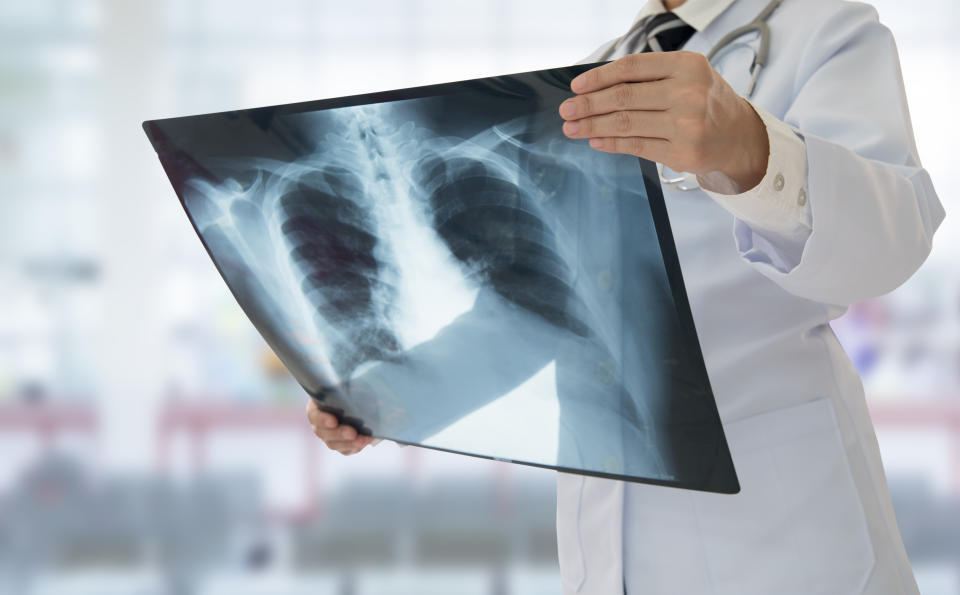One in 100 hospitalised COVID patients in UK has a punctured lung, study suggests

As many as one in 100 patients in hospital with the coronavirus in the UK has a punctured lung, research suggests.
Like the inner tube of a bicycle, damage to the lungs can trigger a tear. Leaking air then accumulates in the space between the lung and the chest wall. In severe cases, the organ can become squashed and collapse, leading to life-threatening complications.
A punctured lung – or pneumothorax – is usually associated with severe respiratory disease, while early research suggests four out of five coronavirus cases are mild.
Although unclear, scans have revealed some coronavirus patients develop cysts in their lungs, which could explain why the infection may trigger a puncture.
Read more: Doctor describes ‘bone-deep weariness’ of working amid a pandemic
Medics from the University of Cambridge’s NHS Trust noticed several patients with COVID-19 – the disease caused by the coronavirus – developed a punctured lung, despite not having any pneumothorax risk factors.
A call out on Twitter led to the team analysing 71 patients from 16 hospitals across the UK. The medics estimated an pneumothorax incidence rate of around 0.91%, even among patients who did not require a ventilator.

‘The response was dramatic’
“We started to see patients affected by a punctured lung, even among those who were not put on a ventilator,” said study author Professor Stefan Marciniak.
“To see if this was a real association, I put a call out to respiratory colleagues across the UK via Twitter.
“The response was dramatic; this was clearly something others in the field were seeing.”
Read more: Steroids could cut risk of death by a fifth in critically-ill COVID patients
The medics were given anonymised information on the 71 patients.
While a more accurate estimate of the rate of pneumothorax among COVID-19 patients requires a much larger study, the patient data suggests a 0.91% incidence.
“Doctors need to be alert to the possibility of a punctured lung in patients with COVID-19, even in people who would not be thought to be typical at-risk patients,” said Professor Marciniak.
Coronavirus aside, punctured lungs are more common among men than women, particularly if they are tall and thin.
Other risk factors include having an existing lung condition, smoking and a previous pneumothorax diagnosis.
If the puncture is small, it usually repairs itself within a few days, with the trapped air gradually being absorbed by the body.
In more severe cases, the air has to be invasively sucked or drained out.
Read more: Man with coronavirus develops testicular swelling
Left untreated, air will continue to get into the space between the outside of the lung and the inside of the chest wall as the patient breathes. This can start to compress the other lung and heart, which can be life threatening.
“Many of the cases we reported were found incidentally – that is, their doctor had not suspected a punctured lung and the diagnosis was made by chance,” said Professor Marciniak.
Lung punctures are not generally associated with viral respiratory infections. Small tears can occur to the outer part of the organ if there is an area of weakness, like a small blister, in the tissue.
Pre-existing conditions like cancer, cystic fibrosis or the bacterial infection tuberculosis can also weaken the tissue.
Survival rates higher among the under 70s
The Cambridge medics found just under two-thirds (63%) of the 71 patients survived, as reported in the European Respiratory journal.
Age was a risk factor for death, with 71% of the patients under 70 overcoming the complication compared to 42% of the older individuals.
The survival rate did not differ between the males and females, however, more men were diagnosed with pneumothorax in the first place.
The scientists wondered whether this could be down to more men developing coronavirus complications in general, with early research highlighting being male as a risk factor.
The patients with abnormally acidic blood – known as acidosis, which can result from poor lung function – also had worse outcomes.
“Although a punctured lung is a very serious condition, COVID-19 patients younger than 70 tend to respond very well to treatment,” said Dr Anthony Martinelli, who co-authored the study.
“Older patients or those with abnormally acidic blood are at greater risk of death and may therefore need more specialist care.”



